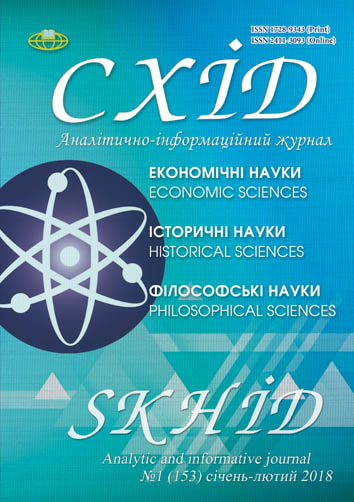The methodological instruments of the capital structure management assessment at the power-producing listed companies
DOI:
https://doi.org/10.21847/1728-9343.2018.1(153).127100Keywords:
economic value added, capital structure, effectiveness, power-producing listed companiesAbstract
The conducted research provides improvements in the indicators system of the diagnostics of the capital structure management effectiveness at the power-producing listed companies that, comparing to the others, is grounded on the analysis of the equity and debt taking into consideration the economic value-added dynamics, which, eventually helps to define issues in the capital structure management process and provide with solid recommendations for further improvement of the decision making. It is substantiated that the system of the indictors has to combine return on invested capital (ROIC), Debt-to-Equity ratio (D/E), effect of financial leverage (EFL), weighted average cost of capital (WACC) and economic value-added (EVA), which is a baseline of the defined indicators. Modification of the economic value-added makes it possible to evaluate the EVA of Equity and EVA of Debt within the capital structure. Therefore, modified EVA formula helps to understand the oscillations in the effectiveness and efficiency of the capital structure components and provide the analytical basis for the stakeholders and their decisions. Defined that, in combination with the other indicators, it is possible to understand the complexity and differentiation of the capital structure at the power-producing listed companies; the relations between owners and the entity and their interests; the mechanism of the value creation as enterprise and Equity and Debt.
Downloads
References
Blank, I.A. (2008). Management of formation of capital. Nika-Tsentr, Kyiv, pp. 656. (rus).
Brigham, E. (1997). Fundamentals of Financial Management [translat.]. Molod, Kyiv, pp. 1000 (ukr).
Varicheva, R.V. (2012). Analysis of the optimality of the equity structure of joint stock companies: problems and prospects. Visnyk sotsialno-ekonomichnykh doslidzhen. Issue. 4, 155-167 pp. Avaialble at: http://nbuv.gov.ua/UJRN/Vsed_2012_4_26
Havrysh, О.А. and Dunska, А.R. (2015). Approaches to management and evaluation of the effectiveness of innovative enterprise development programs. Ekonomichnyi prostir № 94, 179-189 pp. (ukr).
Kovalev, V. V. (2001). Introduction to Financial Management. Finansy i statistika, Moscow, pp. 768 (rus).
Krejnina, M. N. (1998). Financial management. Delo i Servis, Moscow, pp. 304(rus).
Momot, T.V. (2007). Business valuation. Modern technologies. Factor, Kharkiv.
Nіkbaxt, E. and Groppellі, A. (1992). Finances [translat.]. VІK-Globus, Kyiv, pp. 382 (ukr).
Pavlovska, O. V. (1997). Financial methods and levers of employment management in the labor market. Ukrayina: aspekty pratsi,5. 5-9 pp. (ukr).
Savicka, G. V. (2007). Economic analysis of enterprise activity. Znannya, Kyiv, pp. 668 (ukr).
Balvers, Ronald J. and Huang, Dayoung (2009, Apr.). Money and the C-CAPM [Printed edition]. University of Washington, Seattle: Journal of financial and quantitative analysis. Vol. 44, No. 2. pp. 337-368. DOI: 10.1017/s0022109009090176.
Gitman, Lawrence J. and Zutter, ChadJ. (2010). Principles of finance, 13th edn., Prentice Hall, Boston.
Kollar, Boris and Kliestik, Tomas (2014). Simulation approach in credit risk models, In: 4th International Conference on Applied Social Science (ICASS 2014), Information Engineering Research Institute, Advances in Education Research, Vol. 51, pp. 150-155.
Krush, P.V. and Mastiuk, D.O. (2015). The evolution of theoretical approaches to definition of enterprise capital essence, Economic bulletin of NTUU «KPI», № 12. Available at: http://ev.fmm.kpi.ua/article/view/45314/41584.
Madhavi, E. and Prasad, M.S.V. (2015). Assessing Corporate Performance with Measures of Value Added as Key Drivers of Shareholder Wealth: An Empirical Study, The IUP Journal of Business Strategy, Vol. XII(4), pp. 19-34.
Bloomberg, L.P. (2015). Market Investigation. Energy sector: Bloomberg Business. Available at: http://www.bloomberg.com/markets/stocks/futures
Mastiuk, D. and Krush, P. and Valouch, P. (2016). An Economic Value Added as a Measurement Tool of Capital Structure Effectiveness at the Power producing Enterprises. 8th International Conference “Managing and Modelling of Financial Risks”. Ostrava, Czech Republic. 572-580 рp.
Mugoљa, A. (2015). The determinants of capital structure choice: Evidence from Western Europe, Business and Economic Horizons, 11(2), pp. 76-95. DOI: 10.15208/beh.2015.07.
Neumaier, I. and Neumaierovб, I.(2014, March). INFA Performance Indicator Diagnostic System, Central European Business Review, 3(1), pp. 35-41. DOI: 10.18267/j.cebr.73.
Pike, Richard (2009). Corporate finance and investment: decisions & strategies. Prentice Hall Financial Times. Harlow, England.
Brealey, Richard and Myers, Stewart and Franklin, Allen (2010) Principles of Corporate Finance, 10th edn., McGraw-Hill Education. NY.
Stewart, G.B., III (2013). Best-Practice EVA, John Wiley & Sons, Inc.Hoboken, New Jersey.
Stewart, G.B. (1994). EVA: fact or fantasy? J. Appl. Corp. Finance 7 (2), 71-84. DOI: 10.1111/j.1745-6622.1994.tb00406.x.
Van Horne, J.C. (1971). Financial management and policy, 2nd edn., Englewood Cliffs, Prentice-Hall, Inc. N.J., pp. 823 p.
Downloads
Published
How to Cite
Issue
Section
License
Copyright (c) 2018 Dmytro Mastiuk

This work is licensed under a Creative Commons Attribution-NonCommercial-NoDerivatives 4.0 International License.
1. Authors bear responsibility for the accuracy of facts, quotations, numbers and names used.
2. Manuscripts are not sent back.
3. The publisher does not always agree with the authors' opinion.
4. The authors reserve the right to authorship of the work and pass the first publication right of this work to the journal under the terms of a Creative Commons Attribution-NonCommercial-NoDerivatives 4.0 International License. This license allows others to distribute (copy) the published work for non-commercial purposes, provided there is mandatory attribution to its authors and a link to the first publication in our journal.
5. The authors have the right to conclude separate supplement agreements that relate to non-exclusive work distribution in the form in which it has been published by the journal (for example, to upload the work to the online storage of the journal or publish it as part of a monograph), provided that the reference to the first publication of the work in this journal is included.

